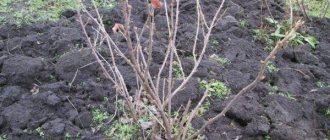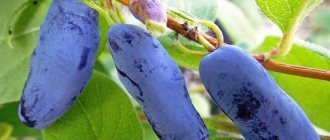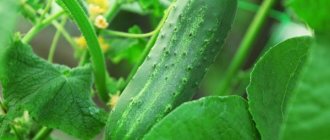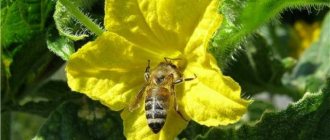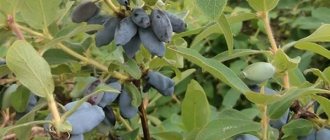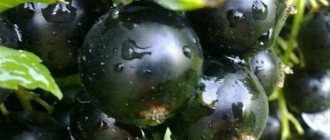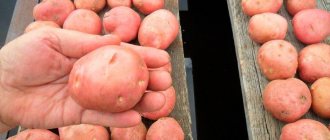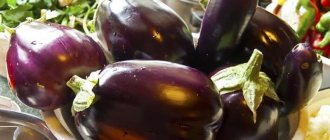With the help of the Tretyakovsky tomato, you can simultaneously decorate your plot and get a very high yield. The hybrid is named after the famous art gallery due to the fact that it has a very picturesque appearance. Such a miracle will surprise not only the owners, but also all the neighbors.
| Height | Landing location | Ripening time | Fruit color | Fruit size | Origin | Fruit shape |
| Tall | Open ground | Mid-early | Pink | Average | Hybrid | Flat-round |
Characteristics and description of the variety
The variety is a mid-early variety - the first harvest is obtained within 110 days from the moment the seedlings are planted in the ground. The bushes are determinate - limited in growth. In the northern regions of the country, the height of the bush is about 1.5 m; in the south - about 1.8 m. Suitable for both growing in greenhouse conditions and open ground. Despite their growth, the bushes are compact and neat, the leaves are dark green.
Tomatoes have an attractive raspberry-red color. The peel is dense, glossy. The pulp is characterized by a juicy and sweet taste, which is why Tretyakovsky is widely used in cooking. The weight of one tomato is about 100-130 g. About 7-9 tomatoes ripen on a bunch.
Features of care
Caring for Tretyakov tomatoes is not much different from caring for other varieties. At the beginning of ripening, watering is advisable no more than once a week. Otherwise, the fruits will be too sour and soft. As soon as 4–5 leaves appear on the stems, gardeners switch to twice-daily watering for a week. Water temperature plays an important role. It should not be below 20 degrees.
A tomato bush is grown with one stem. The shoots that form below take over the responsibilities of the second stem. It is important to remove the remaining shoots.
Even in bad weather conditions, the fruit sets well. Full vegetation of tomatoes is possible only with a sufficient supply of phosphorus, potassium, and nitrogen. It is recommended to apply the first superphosphate fertilizer immediately after planting the seedlings. But it is important not to overdo it, otherwise nitrates will accumulate in the tomatoes. To prevent diseases, tomatoes are treated with ash during the flowering period.
Since Tretyakov tomatoes are a tall hybrid, the length of the bushes can reach 7 meters. To prevent this from happening, plants above two clusters must be pinched.
Advantages and disadvantages
Like any other variety, Tretyakovsky has its positive and negative sides. The advantages include:
- Great hybrid taste. This quality allows you to use the tomato not only for preparing salads and side dishes, but also to make juices, ketchups, and winter preparations from it;
- compact size allows you to use tomatoes for whole canning and pickling - small and neat tomatoes do not crack and look appetizing in a jar;
- ease of care. Even a novice gardener can grow Tretyakovsky. In terms of care, the variety requires only timely watering, removal of weeds and fertilizers;
- versatility of use - the variety is often used not only in cooking, but also in folk medicine and cosmetology. For example, they make tinctures from tomatoes and garlic against coughs and make cosmetic face masks;
- high content of vitamins and microelements. Tomato contains vitamins B, A, C, as well as potassium, calcium, and magnesium. They have a beneficial effect on the human body - they increase stress resistance, are beneficial for the functioning of the heart and blood vessels, and improve immunity. The vegetable is also perfect for dietary and baby food;
- ability to ripen in room conditions;
- hybrid resistance to parasites and pests;
- immunity to sudden climate changes;
- good shelf life and transportability. The variety does not lose its presentable appearance and high taste after transportation.
Among the disadvantages of the variety, the following should be highlighted:
- sometimes individual branches need additional supports;
- the formation of shoots makes it necessary to remove stepsons, which requires additional time and effort;
- getting seeds of the Tretyakov variety is not always easy;
- Although the variety has high immunity to infections, sometimes cases of disease occur.
Advantages and disadvantages
The main advantage of the variety is its productivity.
The advantages of the Tretyakovsky F1 variety also include:
- fleshy fruits with a pleasant raspberry color;
- good taste;
- unpretentiousness to the soil;
- substances that are beneficial for the body in tomatoes.
The disadvantages include increased attention to plants at the growth stage, otherwise there is a possibility of growing “giants” in your garden, the yield of which will be significantly lower.
How to properly grow tomatoes in a greenhouse and in open ground
It is recommended to prepare seedlings 60-65 days before planting. To do this you need:
- Buy seeds at gardening stores. Pay attention to the manufacturer and carefully read the information about the variety on the packaging.
- Prepare the container. Both wooden boxes and plastic pots are suitable for seedlings. The main thing is that the container is dry and clean. You can also purchase special containers in the store.
- Prepare the soil. Today, manufacturers offer a wide selection of ready-made mixtures. They already contain all the necessary substances and microelements. For example, the mixture “Krepysh” or “Malyshok”.
Planting seedlings is a mandatory step. During this time, the seeds feed and develop immunity. The seedlings are kept in a bright and warm place.
Water the sprouts on time; it is also recommended to apply organic fertilizers. In addition, growth stimulants are added. Next, we will consider the features of growing tomatoes in different conditions.
Important! Even purchased seeds are best disinfected. To do this, use hydrogen peroxide or mustard.
In the greenhouse
It is recommended for gardeners in the central part of the country and northern regions to grow the variety in greenhouse conditions. This is explained by the fact that these areas are characterized by sudden climate changes, prolonged absence of sun and heat, and high humidity.
Before planting, it is necessary to disinfect the soil - both using special means and using traditional methods. For example, treat the soil with an ash-based solution - this will help kill the remnants of past infections and prevent the development of diseases in the future. In addition to the soil, be sure to disinfect all hard surfaces in the greenhouse - especially walls and doors.
Important! After planting, first water the bushes with warm water. Be careful not to let water get on the foliage - otherwise there will be a risk of late blight infection. Since the greenhouse is characterized by high humidity, ventilate it periodically.
In the open ground
Planting in the open sky is no different from planting in a greenhouse. The soil must also be treated with special solutions in advance. In addition, it is recommended to apply fertilizers in advance - for example, humus and foliage. This composition will enrich the soil with necessary substances, which will have a positive effect on the future harvest.
Growing seedlings
The most favorable way to grow tomato variety Tretyakovsky F1 is in a greenhouse. Therefore, to obtain an earlier harvest, it is recommended to plant seedlings.
Stages of sowing grains:
- The soil mixture for seeds is prepared. When harvesting land yourself, it is advisable to first disinfect it. To do this, the soil is calcined in the oven. To obtain a fertile mixture, take equal parts of garden soil, compost and sand. The best option is a ready-made store-bought soil mixture.
- Typically, producers of hybrid tomato seeds inform buyers about seed treatment. Therefore, Tretyakov F1 grains can be planted dry. If you want to be on the safe side, you can soak the seeds in warm water and place them in a wet napkin until they germinate (the material is placed in a warm place). The material must not be allowed to dry out, so it is necessary to moisten the fabric periodically.
- On the surface of the moistened soil, grooves 0.5-1 cm deep are made, into which the sprouted seeds are placed at a distance of approximately 2 cm from each other. Seeds of the Tretyakovsky F1 variety are sprinkled with soil and lightly compacted. The box with planting material is covered with film or glass and placed in a warm place (+ 22...+25˚ C).
- After about 5-7 days, the seeds germinate. You can remove the covering material and place containers with seedlings in a bright place.
As soon as two leaves grow on the seedlings, you can plant the sprouts in separate cups. At this stage of growth, Tretyakovsky F1 seedlings are watered once a week. When more than five leaves appear on the stems, watering is carried out twice a week.
The use of lighting is an important condition for growing strong seedlings of the Tretyakovsky F1 variety. For these purposes, a phytolamp is installed near the container. The first time fertilizers are applied to the soil one and a half weeks after transplanting the seedlings. To feed the seedlings, water it once a week with a solution of vermicompost (add 2 tablespoons of fertilizer per liter of water).
10 days before planting the sprouts in the greenhouse, they begin to harden them and take them outside. The time spent in the fresh air is increased gradually.
Resistance to pests and diseases. Fight them
Like most hybrids, Tretyakovsky has excellent resistance to common infections and parasites. However, no one can guarantee 100% immunity, so occasionally the variety gets sick.
Let's look at the most common pests:
- mole cricket - in appearance it resembles a large brown beetle. It penetrates deep into the ground and feeds on the roots of the tomato, thereby disrupting the plant's metabolism and taking away nutrients. It is recommended to fight the mole cricket with the remedy “Rubit” - the medicine is made on the basis of millet. Rubita grains are placed in holes and covered with earth. Medvedkas are eliminated 1-2 weeks after application. The drug is very popular among gardeners;
- The whitefly looks like a small white moth. The cause is often high humidity and heat. They fight the parasite with folk remedies: infusion of chamomile, dandelion, yarrow. Treat the bushes with the mixture - this simple method will eliminate the insect and keep the beds intact;
- The wireworm can destroy most of the crop. To prevent its occurrence, add chalk, lime and ash to the soil in advance. If the parasite has already appeared, it is recommended to use ammonium sulfate or ammonia water. As simple as that, scatter eggshells around your garden throughout the summer.
Diseases include:
- late blight The fungus can destroy most of your crop. Appears as brown spots on the leaves. It is best to fight the fungus with the help of professional products - Quadris, Previkur, Kuproksat. To prevent the disease, gardeners advise carrying out preventive measures - fertilize the plant on time, monitor the watering schedule, disinfect the soil;
- Tobacco mosaic appears as yellow patterns on the leaves. It is necessary to fight the virus using various mixtures. For example, spray the bushes with milk, water and iodine;
- powdery mildew - a disease caused by fungal microorganisms and manifests itself in the form of a white coating. The drugs “Vitaros”, “Raek”, “Skor” will help get rid of it. They can be used even during the ripening of tomatoes; they do not affect the taste and development of the variety.
Caring for mature plants
Caring for tomatoes after transplanting into a greenhouse consists of the following agrotechnical techniques:
- Stepsoning
Removal of stepsons from plants of this variety must be carried out regularly once every 3-5 days throughout the season. Simultaneously with pinching, the bush is formed into one or two stems. When forming into one stem, all side shoots without exception are removed; when forming into two stems, one strongest stepson is left under the first fruit cluster.
- Tying up
By the time they are planted in the greenhouse, the bushes have already reached a height of 25-30 cm, and after a couple of weeks of growth they even reach half a meter. Liana-type bushes are not able to support their weight even without fruits and therefore need support and tying.
- Watering
Watering for such tall plants with a large number of fruits should be plentiful, but rare. The root system of the Tretyakovsky tomato is very powerful and goes deep into the ground. Therefore, watering should be appropriate, about 10-12 liters per bush.
- Feeding
Since the tomato sets a large number of fruit clusters throughout the season, even well-fertilized soil is gradually depleted. In addition, at different stages of development, the plant requires different nutrients. Feeding should be carried out at least once every two weeks, taking into account the phase of plant development and its needs.
- Loosening
Loosening is carried out the next day after each watering. This prevents the formation of a crust on the surface of the earth and improves oxygen access to the roots of the plant. Near the bushes themselves, the soil is loosened carefully, combining it with hilling. You can loosen deep enough between rows while simultaneously removing weeds.
Advice! It is known that the more flowers are pollinated, the greater the harvest. There is no wind or insects in greenhouses, which help plants in this important process. Therefore, during flowering, it is recommended to carefully shake the bushes and ventilate the greenhouse more often.
Reviews from gardeners
On gardening forums you come across the following reviews about the Tretyakovsky variety:
Olga from Moskovskaya: “The bushes grew strong and held up very well. The tomatoes, as stated, are collected in clusters. They do not sit tightly in the hands, weighing 100-110 g each. The taste is typical for a hybrid, but not herbaceous, slightly sweet. Tomatoes picked from the bush are much tastier than those ripened at home. The bushes didn’t hurt in any way.”
Evgeny from the Ivanovo region: “I liked Tretyakovsky. The tomato was green in the greenhouse until October. The yield is good, the color is rich. I will plant tomatoes next year too.”
Nikolay from the Kurgan region: “I was dissatisfied with the Tretyakovsky variety. 3 weeks after planting, the plant was attacked by wireworms. It was possible to cope with it only with the help of special drugs. In addition, the tomatoes did not set well and were slow to gain color.”
History of the Tretyakovsky tomato variety
The Tretyakovsky F1 tomato was bred at the very end of the last millennium in Chelyabinsk; the sale of its seeds is mainly carried out by agro. There is information online that it received state registration in 1999, but currently there is no entry about it in the State Register of Selection Achievements of the Russian Federation. Therefore, official information can only be obtained from the website of the seed manufacturer.
According to this description, the variety may not be recommended to the most experienced vegetable growers. Even without qualified care, it produces very good harvests. However, in many regions, tomatoes of mid-late varieties, which include Tretyakovsky, are not particularly popular, since they do not have time to ripen before the onset of cold weather. Therefore, even in the central zone it is safer to plant this tomato in a greenhouse. It is intended for amateur gardeners; it is unprofitable for industrial production due to the long growing season.
Important features of agricultural technology, amateur reviews
Sowing seedlings in March. It should take 60-65 days from germination to transplanting into the ground onto a permanent bed. External signs of readiness of sprouts: the presence of 5 leaves and one inflorescence. Place no more than 4 bushes on 1 square of land.
Advice. Lead the tomato into 1 or 2 stems. For better ventilation, tear off all the leaves under the ripening clusters from bottom to top.
The hybrid has many reviews online. However, most of them are negative. The germination rate is really high, and the fruits correspond to the declared characteristics in terms of taste and keeping quality. But their color is red, and the overall yield of the plant turned out to be lower than what was promised by the originator. Vera (Moscow), Inna (Sverdlovsk region), Olga (Tula region) write about this. Elena from Cheboksary had the lion's share of her tomatoes eaten up by dampness and its accompanying diseases.
There are also positive opinions. For example, Vera from the Vologda region. It was possible to grow a full-fledged harvest. Tomato Tretyakovsky has good data and conflicting reviews. The cost of hybrid seeds belongs to the premium category.
